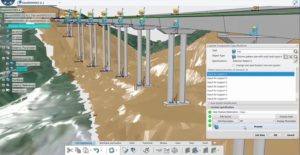IDJ English - Editorial report
Urban Development in Post Corona Era and ODA
An Open and Dynamic Urban Model is Necessary for Future Urbanization
Dr. Tsuyoshi Hashimoto
Chief Executive Director, RECS International Inc.
As urbanization progresses around the world, cities now face various crises such as natural disasters, poverty, terrorism and infectious diseases. Under such circumstances, discussions are afoot about many types of cities including smart cities and eco-cities. What do people need from their cities in the Post-COVID-19 Era? Dr. Tsuyoshi Hashimoto, Chief Executive Director of RECS International Inc., and an editorial writer for the "International Development Journal", discusses. He has been long involved in urban and regional development in developing countries.
Is urbanization inevitable?
Historically, cities developed as venues to exchange products from neighboring villages. The main functions of cities, therefore, are trade and related services including financial and administrative services. Most other economic activities tend to be located in rural areas such as agriculture and mining depending largely on land, water and other resources and tourism capitalizing on natural resources. Manufacturing activities tend to be located in rural areas as well, if they are of resource processing type, while other types may locate close to urban markets.
However, economic and financial globalization and development of the ICT industry are changing the economic structure and relationships between urban and rural areas. For instance, factory-type agriculture that do not depend on endowments of land, water and other resources has been promoted in recent years. Tourism may not be totally constrained by access to natural resources if it is combined with virtual reality to promote virtual tourism just like the world of the movie “Total Recall” (1990). Virtual tourism may be commercialized earlier induced by the recent COVID-19 crisis. In mining, exploration and extraction of mineral resources by AI-operated machines reduce the need for human workers in mining fields. These tendencies will be accelerated by the introduction of 5G and further 6G communication systems.
The service-oriented economy tends to promote further concentration of population in urban areas having various service functions. In fact, the acceleration of urbanization has been increasing the needs for further development of urban infrastructure responding to the needs. Such responsive development of urban infrastructure encourages further urbanization resulting in increased needs for urban infrastructure. This “vicious circle” is a main issue to be addressed for urbanization.
Another issue is what type of urbanization is to be pursued in the globalizing economy. Over-concentration of population in capital cities is considered undesirable in both developing and developed countries. Then, the question is what kind of urbanization is to be pursued in local areas in the globalizing world. The issue is how to avoid over-concentration of population and economic activities in capital cities while enhancing urban functions effectively by both of the capital and local cities to meet the needs of globalization.
“Regional cities” hold a key for developing countries
For a developing country to achieve self-reliant development in the economic globalization, cities that are directly linked to the global market are necessary. They may be called “regional cities”. First, they are multi-functional cities with a population of 500,000~1,000,000. Second, economic transaction costs should be reduced to realize a regional city by proper development of urban infrastructure as well as better urban management.
For a regional city to develop by effectively utilizing direct links with the global market, it must have industries producing exportable goods in its hinterland so that products of exportable quality and quantity are easily accessible at an appropriate price to compete in the global market. Having a surrounding region with viable indigenous industries producing exportable goods and services would ensure a robust economic structure for the regional city.
An example will clarify the relationships between export industries and a regional city. Tsubame City of Niigata Prefecture is famous for its metal works producing high quality kitchen utensils and other products. Some products are highly competitive in the export market, but the city itself with a population of only 80,000 cannot be a regional city. On the other hand, Niigata City, some 30km away, with a population of 800,000 is qualified as a regional city, having major port facilities and an international airport. This allows Niigata City to export the products from Tsubame City to the global market.
To be qualified as a viable regional city, it is necessary that primary and secondary industries in the hinterland of the regional city are linked to the tertiary industry in the city by effective transport and communications infrastructure. Conversely, introduction and application of advanced technology and creation of innovative design by the tertiary industry in the regional city support primary and secondary industries in its neighborhood.
Concepts and conditions of a “resilient city”
Of many models for urban development, smart cities and compact cities aim at efficient provision of public infrastructure services. To realize them, not only hard infrastructure such as various facilities but also soft infrastructure of social capital including proper administration is required. For instance, in case of a smart city, rather than a centrally control system for efficiency, a self-reliant governance structure should be built from buildings and houses, through districts and towns to cities and regions in hierarchical structure. A compact city should not be a self-contained stationary city, but rather mutually complementary relationships with other cities for functional division would be a key to realize self-reliant development together.
Future cities should pursue the urban model with dynamic and open characteristics spatially and temporally. Spatially, these cities would naturally encompass rural and agricultural areas and may extend as necessary beyond national boundaries. Temporally, they should accommodate not only growth and expansion of urbanized areas, but also metabolism and changes in urban morphology, and encompass relationships with rural areas. In designing such an urban model, city networking and the concept of a “resilient city” are important.
A basic form of city networking is a city alliance between small and medium-sized cities for more efficient joint provision of public services such as water supply and solid waste management. An international city networking by large cities may allow complementary development of member cities each specializing in a high-grade urban service, respectively. Possible service functions include storage and supply of basic food products in preparation for food crisis, rescue and restoration from disasters such as earthquakes and flooding, international mechanism for various insurance schemes related to trade and logistics to compensate for economic losses by wars, internal conflicts and disasters, common ownership and use of development fund and funding methods, information sharing for various purposes and property rights.
A resilient city means a city with high capability to adapt to changes in external and internal conditions and to recover quickly from the effects of such changes including natural disasters. It is clear that city networking for mutual development, as mentioned above, is indeed a method to realize a resilient city.
Suggestions for ODA in urban sectors
Based on the discussions above, directions of development cooperation in the urban sector by official development assistance (ODA) may be indicated. As a starting point, advantages of the Japan International Cooperation Agency (JICA) in the urban sector are noted as: 1) broad perspective and regional development approach, 2) practice of a participatory approach for community development and capacity development, and 3) possibilities of cooperation beyond national boundaries. Against these advantages are the most significant challenge in the urban sector regarding how to train the human resources in developing countries not only for urban planning but encompassing also urban development and management altogether. The only way is to muster efforts of both private firms and public organizations for planning and implementing urban development projects.
Particularly for urban development, the private sector should take the initiative, but in order to enhance profitability as well as development effects, urban infrastructure development and legal and institutional measures by ODA should be combined with private businesses. Urban development projects should be promoted by collaborative efforts of private entities including financial institutes, ICT firms and thinktanks among others. Moreover, a mechanism to reflect voices and needs of residents should be built into the projects. At the same time, development assistance by ODA including cooperation with other donors should be sought for urban infrastructure development and legal and institutional measures. The organization of implementing arrangements with private entities, reflection of the voices and needs of residents, and facilitation of donors’ assistance are indeed expected functions of development consultants. These increasingly important functions of development consultants would be performed by linking stakeholders from planning through implementation to operation with software as well as hardware supported by human ware.
International Development Journal 2020 July edition
Supplement: This manuscript was first requested in February, when outline contents were conceived. Due partly to limited space, an important aspect was not discussed, which has become more important with the proliferation of COVID-19.
An open model of urbanization is a prerequisite for city networking to achieve functional division as discussed above. Also, to deal with rapid urbanization and changes in relationships between urban and rural areas, habitation patterns and spatial perceptions, a dynamic urbanization model would be required. Such an open and dynamic city is in the opposite of city lockdowns recently taken as countermeasures against the COVID-19 crisis. The city lockdowns were undertaken by strong national authority, which is against the universal trend of localization of development administration for city networking, local autonomy and city alliances.
Another condition for a new urbanization model is, in fact, urban governance to cover areas much larger than the city itself. This may be called “region-based urban governance” as a form of localization of development administration. In the network society supported by 5G and 6G communication systems, urban residents may perceive surrounding rural areas as a new form of “satoyama” or home countryside, and rural residents may work for service industries in the nearby city, receiving remote education and health services. These possibilities may be effectively promoted by region-based urban governance. New urban governance covering enlarged urban area encompassing urbanized area and surrounding rural area may facilitate fundamental solutions to various urban problems.
*****以下、日本語原文*****
視点 ポスト・コロナの都市開発とODA
求められる“動的で開かれた”都市モデル
国際開発ジャーナル論説委員
(株)レックス・インターナショナル 代表取締役
橋本 強司氏
世界的に都市化が進む中、都市は今や、自然災害や貧困、テロ、感染症など、さまざまな危機に相対している。そうした中でスマートシティやエコシティなど、さまざまな都市の在り方が議論されているが、ポスト・コロナにおいて都市に求められるものとは何か。開発途上国の都市・地域開発に長年携わってきた本誌論説委員の橋本強司氏が論考する。
都市化は必然か
歴史上、都市は農村における余剰生産物の交易の場として成立し発展した。したがって都市の基本的機能は、交易・商業そして金融、さらには行政などのサービスである。一方、土地や水などの資源に依存する農業や鉱業、さらには自然を生かした観光業は、資源が広く賦存する地方に立地する。製造業は資源加工型の場合は資源に近い地方に、他は市場に近い都市周辺に立地する。
しかし、経済や金融のグローバル化およびICT産業の発展によって、産業構造や都市と農村との関係は変化しつつある。例えば農業では、必ずしも土地や水などの賦存に規定されない工場型農業が推進されている。観光業も映画「トータルリコール」(1990年)の世界のように仮想現実と連携して場の制約を少なくできる仮想観光が検討されており、新型コロナウイルスの感染拡大をきっかけに事業化が進むと期待される。鉱物資源の開発でも、人工知能(AI)による採掘機械などの遠隔操作が進み、マンパワーの必要性が低下する。これらの動きは、5G(第5世代移動通信システム)、6Gによってさらに加速するだろう。
経済のサービス化は、サービス機能を提供する都市へ人口集中を助長する。実際、都市化趨勢の加速により、都市インフラ整備の必要性は増している。だが、後追いのインフラ整備がさらなる都市化を助長し、それが都市インフラのニーズをますます高めるといういたちごっこが続いているのは課題の一つだ。
もう一つの課題は、どの様な都市化を目指すかである。首都圏への一極集中は望ましくないという議論は開発途上国・先進国を問わずあるが、では地方における都市化はどうあるべきなのか。人口と経済の過度の集中を避け、首都圏・地方都市を合わせていかに都市機能を高めるかが課題である。
途上国の発展促す「地域都市」
経済グローバル化の中で途上国が自立的発展を実現するには、グローバル市場と直接リンクする都市が必要である。そのような都市を私は「地域都市」と呼んでいる。その条件は人口が少なくとも50万~100万人の多機能都市であること、そして、当然のことながら経済交易コストが低いことである。これら条件を満たすには、都市インフラ整備が必要だ。
地域都市がグローバル市場との直接的なつながりを活用して発展するためには、近隣都市・地域から集積する製品を輸出できる量と質および価格を確保する必要がある。輸出しうる製品やサービスを供給する地場産業を地域内に有することが、地域都市におけるロバスト(強靭)な産業構造につながる。
輸出産業と地域都市について、一つ例を挙げよう。金属加工工業で有名な新潟県の燕市(人口約8万人)は、高い輸出競争力を持つさまざまな金属製品を製造するが、地域都市ではない。一方、30㎞程離れた新潟市(人口約80万人)は、港湾・空港を擁し地域都市としての条件を満たし、燕市からの金属製品をグローバル市場に直接輸出することができる。
活力ある地域都市であるためには、適切な運輸・通信インフラによって都市の三次産業とつながった、豊かな一次産業・二次産業が広域圏に存在する必要がある。逆に地域都市の三次産業における先進技術の導入・適用や革新的デザインの創出が、一次産業・二次産業を支える。
「レジリエントシティ」に注目
このほかに、近年はさまざまな都市開発モデルのうち、スマートシティやコンパクトシティは、公共インフラサービスの効率化を目指すモデルである。これらを実体化する上では、行政を含めた社会関係資本の拡充が必要である。例えばスマートシティでは、中央制御による効率化にならないよう、住居・建物から地区、都市、地域へと自立的に階層化されるためのガバナンスの仕組みが必要である。コンパクトシティは、自己完結する定常的都市ではなく、他の都市との関係による相互補完性を目指す仕組みが自立的発展のカギとなるだろう。
これからは、“空間的・時間的に動的で開かれた”都市モデルが求められる。空間軸としては、当然のこととして農村域を含み、国境を越えることも必然である。時間軸は、単に都市の成長・拡大だけでなく、都市の代謝や都市形態の変化・展開、農村域との関係の変化などを視野に入れる必要がある。このような都市モデルを構想する上では、都市ネットワークと「レジリエントシティ」の概念が重要である。
都市ネットワークは、中小都市が限られた資源を共有して、広域でより効率的な公共サービス(例えば上水供給や廃棄物処理)を提供する都市アライアンスが原形といってよい。国際的な都市ネットワークでは、比較的大きな都市が高度都市機能において機能特化を図るとともに、他都市との連携によって相互補完的発展を図ることが可能となる。例を挙げれば、食糧危機に備えた基礎的食糧の備蓄・供給、地震・洪水などの災害に際しての救援・復興、災害や内戦などによって物流が阻害された際、経済的損失に対して補償する取り決めなど物流に係る各種保険の国際的仕組み、開発財源や財務手法の共有・共用、各種情報ネットワークや知的基盤などがある。
レジリエントシティは、自然災害に速やかに対応し復興を進めるなど、外的・内的状況の変化に対して適応する能力が高い都市を意味する。前述の都市ネットワークによる相互補完的発展は、まさしくレジリエントシティの実現方法なのである。
ODAの方向性
以上を踏まえて、これからの日本の政府開発援助(ODA)による都市開発支援の方向性を示したい。まずこれまでのODAを通じて培った国際協力機構(JICA)の優位性として、1)広域の視点、地域開発の発想、2)参加型の実践、コミュニティー開発、キャパシティ・ディベロップメントの経験、3)多国間にまたがる支援の可能性、を上げたい。他方、都市開発支援の最大の課題としては、都市計画の人材すら乏しい途上国において、都市開発・経営まで含めた人材育成を一気に進めるにはどうすべきかを問う必要がある。
都市開発においては、民間企業の主導が重要であるが、民間事業の収益性および開発効果を高めるために、ODAによる都市インフラ整備や法制面の整備を組み合わせることが重要である。金融機関、ICT企業、シンクタンクをも含む民間企業を糾合し、さらに住民の声やニーズを反映する仕組みを織り込んで都市開発事業を推進する。これに伴い、その前提となるインフラ整備や法制面については、他ドナーとの協調も含めてODAによる支援を仲介する。これらは開発コンサルタントの重要な役割である。関係者間をつなぎ、事業を企画から実施・運営までつなぐための、ヒューマンウェアに支えられたソフトウェアが、ますます重要だということである。
『国際開発ジャーナル』2020年8月号掲載記事
補論:本稿の執筆について、最初に打診を受けたのは2月であり、そのとき概ね内容を構想した。今回掲載された記事では十分に論じなかった面があり、その面はコロナ禍の広がりによって重要性が増したので、以下補足をしたい。
本項で論じた都市ネットワークによる機能分担のためには、開かれた都市であることが必要である。また急速な都市化及びネット社会による都市と農村の関係や居住形態、更には空間認識の変化に対処するために、動的な都市でなければならないだろう。このような動的で開かれた都市は、最近のCOVID-19対策としての都市封鎖とは対極にある。今回の都市封鎖は、強力な国家権力によって実施されたものであり、都市ネットワークや地方自治、自治体アライアンスといった開発行政の地方化という世界的趨勢に反する。
新しい都市モデルのもう一つの条件は、開発行政の地方化を前提とする広域行政、即ち広域都市ガバナンスである。5G更には6Gに支えられたネット社会において、都市域の住民が周辺農村域を「新しい里山」と捉えるような空間認識、農村域の住民が都市におけるサービス業に従事し、保健・教育等の遠隔サービスを享受する可能性、これらは広域都市ガバナンスによって推進できる。農村域を包含する都市域という新しい行政単位に対して都市ガバナンスを考えることは、抜本的都市問題解決の一つの方法となり得る。




ジャーナル2020年7月号「世界を読む」-300x141.jpg)